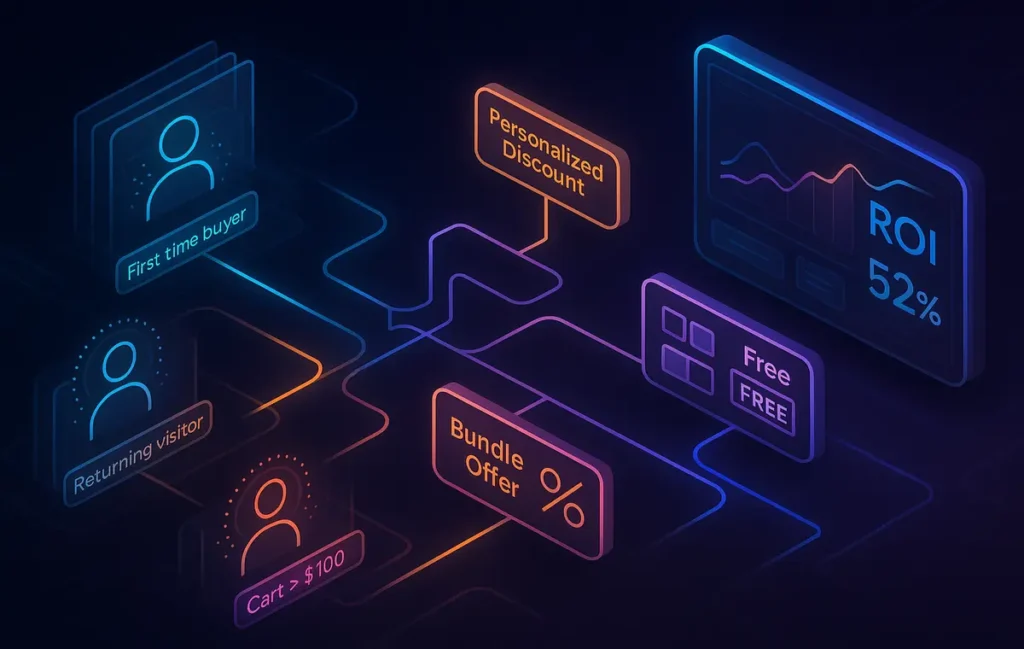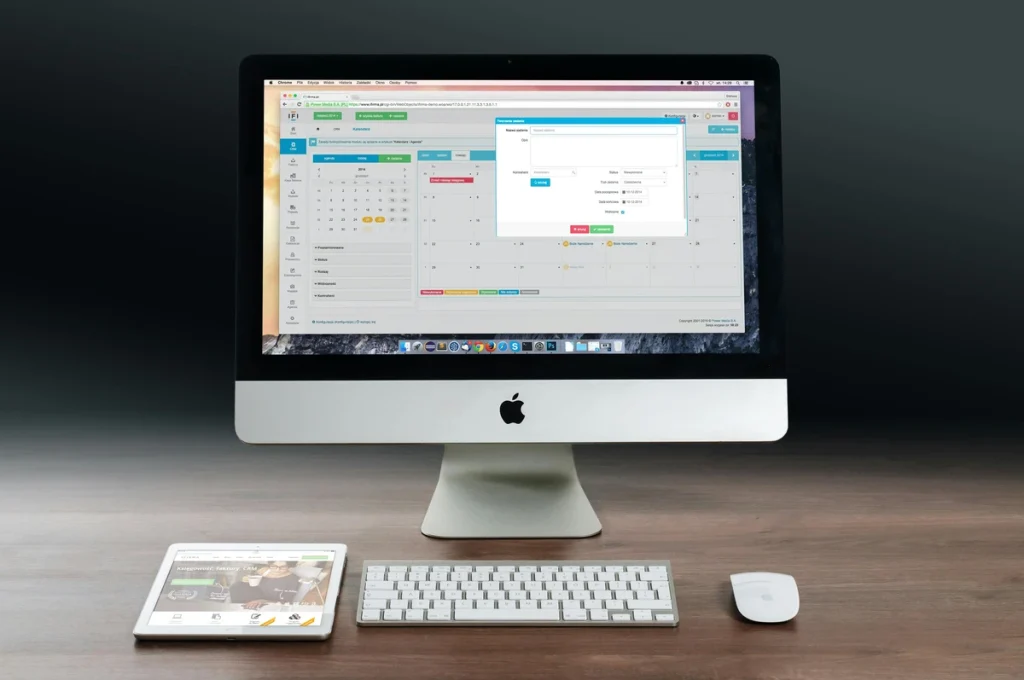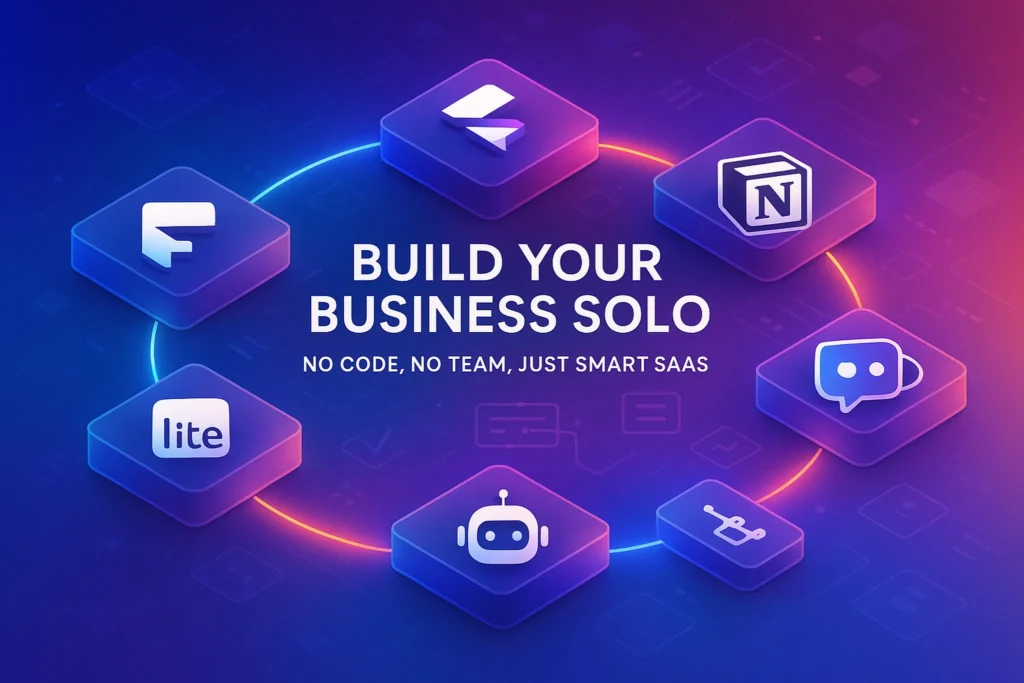🎯 Intro
Universal coupons used to feel generous. In 2025, they feel lazy. Shoppers expect the price they see to reflect their context—new vs. loyal, cart size, channel, even time sensitivity. Meanwhile, merchants need to grow conversion without burning margin. That’s the role of the modern Offer/Promotion Engine: a rules-and-data layer that personalizes incentives, assembles bundles on the fly, and runs continuous experiments across web, app, email, and SMS.
In this NerdChips pillar, we’ll translate promotion engines from buzzword to practice: what they are, how they differ from old-school couponing, which platforms are worth considering, and how to deploy a 90-day rollout that’s respectful of margin and brand. We’ll also share field-tested recipes (abandonment saves, first-purchase accelerators, loyalty nudges) and show you how to measure incremental lift—not just “discounted revenue.” If you’re building the growth stack around marketing ops, pair this with Best Marketing Automation Platforms for Scalable Growth, run smarter tests via A/B Testing Made Easy, and close the loop with Marketing Attribution Software and Best Email Personalization Tools for E-Commerce.
💡 Nerd Tip: Treat discounts like medicine—precise dose, clear indication, minimal side effects. Promotion engines are the prescription pad, not the candy jar.
🧩 What Are Promotion Engines (and Why They Replaced “Coupons”)
At a glance, a promotion engine looks like a rules dashboard: “10% off for cart ≥ $100” or “Buy X, get Y.” Under the hood, it’s a policy computer that evaluates context in real time—user segment, session behavior, inventory, campaign, attribution—and then triggers the right incentive with the right delivery (inline pricing, coupon reveal, post-purchase credit, or loyalty points).
The difference from generic coupons is threefold. First, personalization: incentives adapt per user or segment (e.g., high-intent returner vs. cold prospect). Second, experimentation: A/B or multi-arm testing chooses between rule variants (20% vs. $10; bundle A vs. B). Third, governance: guardrails protect margin (e.g., never stack below target contribution) and enforce eligibility (e.g., channel-specific or one-time use).
Done right, engines create behavior change—not just lower prices. A bundle that increases exposure to a new category can grow long-term value; a timeboxed “win-back” offer can balance revenue with reactivation probability. Teams that graduate beyond “sitewide XYZOFF” routinely report 5–12% AOV lift on targeted bundles and 2–5% conversion lift on abandonment saves, while reducing blanket discount costs by 15–30% through eligibility and caps.
💡 Nerd Tip: Define what behavior you’re buying before designing any discount. “Faster second order within 30 days” is a clearer goal than “more revenue this week.”
⚙️ Core Features You Actually Need (Not Just Nice-to-Have)
Personalized Discounts
Instead of one-size-fits-all, engines evaluate propensity and risk. A shopper with high intent might respond to free expedited shipping (time value) while a coupon-driven visitor needs a small, immediate percentage off. Many teams add a “do-nothing” arm to discover how often no discount wins once UX friction is solved. Over time, reinforcement learning or simple uplift models prioritize profit per discount rather than raw conversion.
Dynamic Bundles & Price Composition
Bundles push exposure into new SKUs or higher tiers without “feeling” like a sale. Smart engines compose bundles from co-purchase graphs (what sells together) and stock levels, ensuring availability and healthy attach rates. Think “Starter + Refill” or “Core + Pro add-on at 30% off,” surfaced inline on PDP or cart. The win is twofold: AOV up and SKU discovery without slashing list prices.
A/B & Rule Testing at the Rule Level
It’s not just testing creatives; it’s testing policies. Compare “$10 off $75” vs. “12% off” vs. “free shipping,” each with eligibility logic (new users only; non-affiliate traffic; first purchase). Use holdouts and geo splits to estimate incrementality. Quietly, rule testing is where most teams uncover that a carefully-timed no-code-needed free shipping beats a deeper percentage discount for logistics-sensitive categories.
Multi-Channel Delivery
Promotions fail if they only live on site. Modern engines pipe offers to email, SMS, app, and even customer support so the same rulebook governs all touchpoints. Your lifecycle tool sends the message; the engine supplies eligibility and the unique code; your site honors redemption. This eliminates the “my email says 15%, site says 10%” dissonance.
Analytics & ROI Tracking
Without measurement, discounting becomes a habit. Engines should log exposed vs. redeemed, margin impact, AOV, units per order, and downstream retention (did the bundle nudge a second category?). Combine with Marketing Attribution Software to avoid double counting when paid campaigns and offers overlap. The gold standard is incremental profit per 1000 sessions of exposure.
💡 Nerd Tip: Add a cost of capital to ROI math. A post-purchase credit has delayed cost—sometimes better for cash flow than an immediate discount.
🧪 Top Promotion Engines (2025): What They’re Great At
Talon.One — Rule Engine with Surgical Control
Talon.One is a policy designer’s playground. You define conditions, effects, priorities, capping, and stacking with near-programmatic flexibility. It shines when you need hierarchies (e.g., loyalty tiers), caps (per user, per day, per campaign), and complex bundles that pull from live inventory. Strengths: granular control, governance, and robust APIs. Weaknesses: requires thoughtful modeling; smaller teams may feel the learning curve. Best for mid-market and enterprise stores that treat promotions as a product.
Voucherify — API-First Coupons, Gift Cards & Referrals
Voucherify nails the coupon, code, gift card, and referral primitives with strong anti-abuse controls (unique codes, redemption limits, distribution lists). It’s excellent for SMB/mid-market teams that want solid building blocks, decent segmentation, and straightforward integration without the heft of a full decisioning layer. Strengths: speed to value, price/value balance, developer docs. Watch-out: for ML-driven personalization, you’ll likely pair it with a CDP or lifecycle tool.
Dynamic Yield — Personalization Meets Promotions
A personalization platform that speaks offers fluently. Dynamic Yield lets you target who sees which promotion across web and app, with audience building, recommendations, and templates. If your brand already runs dynamic content and wants promotions to slot into those experiences, it’s a natural fit. Strengths: audience/experience coupling, UI for marketers. Watch-out: rule complexity is less “infinite” than a pure engine; great if your bias is “experience first.”
Optimizely — Experimentation-Driven Offers
When you want to treat promotions as experiments, Optimizely’s heritage shines. Its decisioning plus experimentation stack lets you A/B/C policies and power feature flags for progressive rollouts. Strengths: stats and governance for testing, tight feedback loops. Watch-out: you’ll still need a coupon/gift card primitive from your commerce platform or a companion tool.
Qubit — Commerce-Focused Merchandising & Offers
Qubit leans into eCommerce merchandising. If you live in categories with frequent catalog refreshes, Qubit’s product discovery + offer surface pairing can push the right bundles at the right time. Strengths: retail DNA, on-page experiences. Watch-out: if your use case is heavy on gift card logic or referrals, you may augment with a dedicated code platform.
💡 Nerd Tip: “All-in-one” can be slower to adopt than “paired best-of-breed” (e.g., Voucherify + Optimizely). Choose time to first controlled rollout over theoretical elegance.
📊 Quick Comparison
| Platform | Best Fit | Why Choose It | Potential Trade-offs |
|---|---|---|---|
| Talon.One | Mid-market/enterprise needing granular rules | Caps, stacking, priority logic; deep governance | Steeper learning curve; requires modeling discipline |
| Voucherify | SMB–mid with strong coupon/gift/referral needs | Fast to value; great anti-abuse; fair pricing | Pair with CDP/experimentation for advanced targeting |
| Dynamic Yield | Personalization-first brands | Rich audience targeting + offers in one UI | Not a pure policy computer; relies on its experience layer |
| Optimizely | Test-led orgs | Treat rules as experiments; strong stats | Needs coupon/gift primitives from commerce or add-on |
| Qubit | Retailers, merch-heavy | Commerce templates; bundle surfacing | Less emphasis on advanced code logic |
⚡ Stop Burning Margin. Start Buying Behavior.
Spin up your first targeted rule—abandonment save, first-purchase accelerator, or loyalty nudge—using Talon.One, Voucherify, or Optimizely. Ship in days, not months.
🏗️ 90-Day Rollout Playbook (From “Blanket Code” to “Policy Engine”)
Days 1–14: Definition & Data Plumbing
Write three business behaviors you’ll buy with incentives: “Recover 12% more abandoned checkouts,” “Accelerate second order within 30 days,” “Increase attach of Accessories by 8%.” Map the eligibility data needed—new/returning, cart value, product tags, traffic source, loyalty tier. Ensure events and identities flow into your engine and lifecycle tools. If you don’t have a CDP, a lean schema in your commerce + ESP can suffice.
Days 15–30: Model the First Rules (Plus Holdouts)
Design one rule per outcome with a holdout arm. Example: Abandonment Save—arm A: free shipping; arm B: $10 off $75; arm C: no incentive (beautiful reminder only). Define caps (max 1 exposure/user/7 days) and guards (never below contribution margin). Instrument exposure, redemption, revenue, margin, and next-order timing.
Days 31–45: Multi-Channel Delivery
Pipe the same rule to onsite, email, SMS, and support. Your ESP triggers the message; the engine returns eligibility + code. Align creative so the value prop and terms match. In cart/checkout, render the incentive inline where possible to reduce code entry friction.
Days 46–60: Launch, Learn, and Cut Bloat
Run for at least two full buying cycles. Review incremental profit per 1000 sessions. Kill arms that win “gross revenue” but lose margin (common with deep percent-off that attract coupon hunters). Keep “do nothing” arms that perform surprisingly well with better UX.
Days 61–90: Expand with Bundles & Loyalty
Add a bundle policy driven by co-purchase graphs: “Core + Refills saves 12%” shown post-PDP add-to-cart. Introduce a loyalty-tier nudge: bronze sees “earn 2x points” rather than raw discount. Wire campaign-level reporting to Marketing Attribution Software to avoid double-counting paid credit card offers or affiliate incentives from Best Affiliate Marketing Software.
💡 Nerd Tip: Build a “kill switch” for any rule. If costs spike (e.g., shipping rates), ops can pause affected offers instantly from the same policy layer.
🧪 Field-Tested Offer Recipes (Use Cases You Can Ship This Week)
Abandoned Checkout Save (Behavior: Return & Complete)
Send a same-day reminder with friction relief first (guest checkout, saved cart). Offer branch: if cart ≥ threshold or includes high-margin SKUs, surface free expedited shipping; else show a small fixed discount. Keep one holdout with no incentive but improved UX copy. Teams see 2–4% absolute recovery lift with careful capping.
First-Purchase Accelerator (Behavior: Convert New Users Faster)
For new visitors who view ≥2 PDPs and start checkout within 48 hours, show an inline welcome bundle (Core + Accessory at a modest net discount) instead of a sitewide percentage. This protects margin and sets the second order up with accessories already in use.
Loyalty Tier Nudge (Behavior: Earn vs. Burn)
Bronze sees 2x points on targeted categories; silver gets early access to limited drops; gold gets free alterations/expedited shipping. Monetary discounts become last resort. This reframes value around status and time instead of raw price.
Attach-Rate Builder (Behavior: Grow AOV with Relevance)
On PDP and cart, offer a guided bundle pulled from co-purchase data (“Creators also add the Pro Mic at 15% off when bought with this mixer”). Apply a hard cap on discount for carts containing low-margin items—guardrails live in the engine.
Affiliate-Aware Offer (Behavior: Avoid Double Payouts)
Traffic tagged with affiliate source gets value adds (bonus points, extended return window) while non-affiliate cold traffic sees a modest fixed discount. This prevents paying affiliate + deep discount simultaneously, keeping CAC sane. Tie reporting back to Best Affiliate Marketing Software to reconcile.
💡 Nerd Tip: Publish plain-language eligibility (“New customers only. One per person. Ends Sunday.”). Transparency reduces support load and builds brand trust.
🛡️ Legal, Trust & UX (Make It Feel Fair)
Shoppers accept rules they understand. Write copy that is clear and conspicuous, avoid dark patterns (like showing a discount that quietly disappears at checkout), and never tie essential information (sizing, returns) behind coupon gates. Keep stacking behavior predictable: if an item is already on sale, say so; if codes don’t stack, show why and offer the best single option automatically.
Operationally, guard against coupon leaks by generating unique codes, scoping them to channels, and expiring on schedule. Support teams need read-only access to validate eligibility and one-time courtesy credits that respect the engine’s caps. When in doubt, give support a “policy-compliant override” they can apply transparently, then log it for post-mortem.
💡 Nerd Tip: Add a “Fair Price Pledge” block on PDPs summarizing how promos work. It turns policy from “fine print” into part of your brand promise.
📈 Measurement: From “Discounted Revenue” to Incremental Profit
The most common mistake in promotions is counting gross sales and calling it a win. Instead, measure incremental profit:
-
Start with exposed sessions vs. holdout.
-
Compute incremental conversion and AOV delta.
-
Subtract discount cost, incremental fulfillment (shipping upgrades), and affiliate fees if any.
-
Track repeat behavior (second order within 60 days, category expansion), because smart offers should influence trajectory, not just the first checkout.
Teams that switch to this lens often shelve 30–40% of their legacy codes within two months, while doubling down on low-cost, high-value perks (shipping upgrades, loyalty multipliers). Tie results back to A/B Testing Made Easy for statistical confidence and keep your attribution aligned with Marketing Attribution Software to avoid ugly end-of-month reconciliations.
💡 Nerd Tip: Report weekly on profit per 1000 exposures. It normalizes traffic swings and makes offers comparable across channels.
🪵 Challenges & Fixes (You’ll Hit These—Here’s How to Clear Them)
Tooling Feels Complex
Start with a single behavior and a single rule. Prove lift, then layer. Too many knobs invite “test soup.” Promotion engines reward focus.
Discount Abuse & Code Sharing
Issue unique codes, scope by channel, cap by user/device, and rotate frequently. Provide a “best available” auto-apply function so entering random codes never feels necessary.
Margin Creep
Lock rule guards around contribution margin and max exposure per user. Review a “discount P&L” separate from revenue P&L so finance has line-of-sight.
Attribution Fights
Agree on a source-of-truth (e.g., GA4 with a consistent lookback) and a promotion attribution rule (last eligible exposure within 7 days). Document it. Share it. Stick to it.
Personalization Blind Spots
If your data is thin, use behavioral proxies (pages viewed, time on site, items interacted) and simple segments (new vs. returning, source). Fancy ML can come later.
💡 Nerd Tip: Put an “off switch” at the top of your rule stack. One click pauses non-essential offers during ops incidents or margin shocks.
💬 Voices from X (What Practitioners Say)
“We replaced sitewide codes with three rules and a holdout. Discount cost down 27%, revenue flat, profit up. The engine made ‘no discount’ a valid arm.” — Ecommerce Growth Lead on X
“Bundles won A/Bs we thought coupons would. AOV +9%, NPS unchanged. Shoppers loved ‘value,’ not ‘cheap.’” — DTC PM on X
“Biggest win was governance. Caps + stacking rules saved support and stopped internal coupon wars.” — Head of CX on X
💡 Nerd Tip: Screenshot and share your weekly “profit per 1000 exposures” chart with marketing + finance. Shared language stops the coupon tug-of-war.
📬 Want more revenue wins with fewer discounts?
Join our free newsletter for promotion recipes, rule templates, and ROI calculators—designed by NerdChips for modern growth teams.
🔐 100% privacy. No noise. Just systems that print profit.
🧠 Nerd Verdict
Promotion engines transform incentives from a blunt instrument into a precision policy layer. Personalized discounts nudge the right shoppers at the right time, bundles grow AOV without cheapening the brand, and rule-level A/Bs keep everyone honest. When you wire the engine into your lifecycle tools and attribution, you stop arguing about codes and start instrumenting behaviors. The result many teams see: fewer discounts, higher profit, cleaner ops. That’s not hype—it’s governance plus experimentation, executed well.
❓ FAQ: Nerds Ask, We Answer
💬 Would You Bite?
If you had to launch one rule this week, would you start with an abandonment save that pays for itself fast, or a first-purchase bundle that sets customers up for higher LTV?
Crafted by NerdChips for creators and teams who want their best ideas to travel the world.



